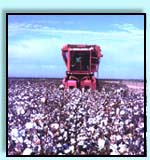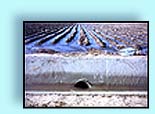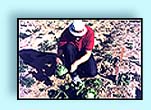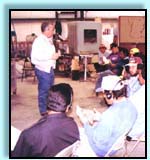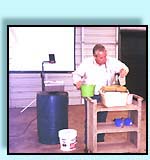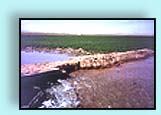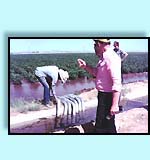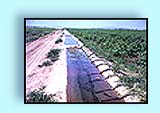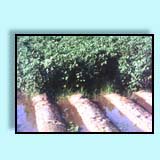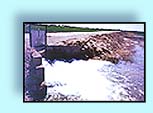|
Written
for Presentation at the Disney's
Coronado Springs Resort, Orlando, Florida, |
|||
|
Traditional Extension programs in agriculture have focused on growers as the main clientele. Although it is true that, in many instances, the growers are making the farm management decisions, often farm workers carry out these decisions - and are in fact the ones responsible for the outcomes. In Arizona, Extension programs dealing with irrigation and water have always targeted the growers. However, it is the irrigators who actually apply the irrigations; they mainly decide when to stop an irrigation or how long to leave the system running. This paper details a workshop that was designed to teach irrigators about plant-soil-water relationships and the interactions between plants and their environments. The workshop was presented in a bilingual format due to the fact that a majority of the irrigators in Arizona speak Spanish as their primary language. The workshop was successful, although attendance fell short of the number of irrigators the team aspired to reach. |
||
|
There are approximately 420,000 ha of cropland in Arizona. Of that, about 99% is irrigated. The crops irrigated range from row crops such as cotton, wheat, barley, and corn, to vegetable crops such as head lettuce, leaf lettuce, broccoli, onions, and cauliflower. There are also several tree crops grown in Arizona, including citrus crops such as lemons and grapefruit, as well as apples, peaches, and apricots. The majority of these crops are surface irrigated. Although each farm may vary with system type (i.e., level-basin, sloping furrow, etc.), all farms share one commonality: irrigators. Nearly every farm hires farm hands whose primary duty is to irrigate the crops. Good irrigators may stay with a particular grower for several years, although many are seasonal workers who move from place to place to find work. In Arizona, surface irrigation via siphon tubes is still the preferred method. Although there are many alternatives to siphon tubes (i.e. ports, gates, etc.), growers still use the siphon tubes based on seasoned experience and low costs. To install gates and ports requires capital - capital that most growers either do not have or would rather spend elsewhere. Consequently, the irrigators are given most of the responsibility for irrigating the crops. Traditionally, Extension programs have focused on the decision maker. In agriculture, this is most often the farmer and family who run the day-to-day operations and take care of the management and money issues. This is still the case in Arizona. With regard to irrigation management, it is the grower who decides when to irrigate. In some cases, the grower may even provide the irrigator with a specified length of time for an irrigation; however, for the most part, it is the irrigators who determine the duration of an irrigation. When working with surface systems, it is often difficult to determine when to stop an irrigation as the water flows down the field. In most cases, irrigators will over-irrigate to assure that they do not cause water stress to the crop. This is a form of ensuring job security. For several years, Arizona Cooperative Extension has been trying to help growers reduce their irrigation water applications. Workshops have been offered on irrigation scheduling, crop water requirements, soil moisture measurements, and weather effects on plant water use. All of these efforts have met with limited success. Eventually, researchers working with growers noted that, when questioned regarding irrigation set times and flow rates, the growers often turned to their irrigators for this information. It was then decided that an Extension program should be developed for the irrigators, the individuals actually applying the irrigations. A grant was secured from the Arizona Department of Water Resources, Pinal County Active Management Area (AMA), to develop and deliver a course in irrigation management to help irrigators conserve the State's water resources. The grant stipulated that the courses be offered in the Maricopa-Stanfield Irrigation and Drainage District (MSIDD), the Hohokam Irrigation and Drainage District (Hohokam), and the Central Arizona Irrigation and Drainage District (CAIDD); all are within the boundaries of the AMA. |
|||
|
The range of material covered in the course was determined by a team consisting of Extension professionals, members of the Arizona Department of Water Resources, local NRCS employees, and Conservation District members. One factor that emerged during the early development of this project was that many irrigators speak Spanish as their primary language. It was then decided that all materials should be offered in both English and Spanish, and that it would be necessary to provide translation in some form during the workshop. Several methods of translation were considered - one was to split the class into English- and Spanish-speaking groups. The presenters would alternate, so that one portion of the class would be given to the English-speaking irrigators, while another was presented through an interpreter to the Spanish-speaking irrigators. However, it was decided that the logistics of this method would become excessively complicated. Another approach considered by the team was the use of simultaneous translation, a format often utilized in international meetings. This method would allow all of the irrigators to be present in the same room and able to hear the workshop at the same time. The team chose to invest in the equipment. Translation of the oral portions of the class necessitated rental or purchase of special equipment. Essential apparatus included microphones, receivers, and transmitters. The team consulted several companies regarding this equipment, and found that each company offered a specialized brand of the necessary equipment. Several discussions with company representatives revealed that the wireless setup was the state-of-the-art format for translation equipment. The wireless format allows the participants to move about freely in the room and sit wherever they wish. This setup was chosen so that all the Spanish- speaking participants wouldn't necessarily be segregated; this way, the language barrier wouldn't necessitate a physical barrier. The total price for the complete set of translation equipment amounted to approximately $3,000, purchased from Williams Sound, a company that specializes in equipment for translation and for the hearing impaired.
The first piece of equipment needed was a transmitter. Since the class was to be translated solely into Spanish (one language), a single channel transmitter was adequate. The transmitter used has a range of 100-150 meters.
In order to transmit to the participants, the translator needed a microphone. A headset with a boom microphone, similar to those used by phone receptionists, was purchased. The headset boom places the microphone directly in front of the translator's mouth, allowing the translator to speak softly and still be heard clearly.
The participants needed lightweight and adjustable receivers, with easily cleaned or replaceable ear pads. The model chosen by the team was a personal receiver with a headset. This type of receiver runs on a 9-volt battery. Sized to fit into a shirt pocket, the receiver used was single channel and came with built-in volume adjustment. A headset plugs into the receiver to fit comfortably over the participants' ears. This setup, as a unit, closely resembles a personal tape player. |
|||
|
The material covered in the class was an explanation of basic plant-soil-water relationships meant to help irrigators better understand what is happening in the field when they irrigate. For the most part, these irrigators are doing a good job - or else they would not have a job. However, the team thought that the irrigators needed to be kept abreast of some of the more technical aspects of irrigation management. Also, the team hoped to empower the irrigators to let them know just how important their task is to the overall economic welfare of the farm. For most farms in central Arizona, water is the highest cost in the farm budget. The course was split into four major categories. Each category covered a different aspect of irrigation, soil, plants, and water. |
||
|
|||
|
Differences between various types of irrigation systems, in terms of water use and irrigation efficiencies, were discussed. Participants learned that not all surface systems are the same and that many times, system efficiencies will change from field to field. The participants learned about land preparation and land-leveling to achieve high efficiencies in surface systems. It was noted that the irrigators (the participants) were likely the only farm workers who could actually determine which fields needed leveling work, because they knew which sets took more water. An irrigation slide rule (Martin et al, 1997), donated by the Casa Grande-Coolidge Hydrologic Unit Area Project, was handed out to each participant. The slide rule can be used to determine the amount of water applied, or the length of time for an irrigation set to achieve a certain irrigation amount, given a certain efficiency. The slide rule uses the Q*t=d*A equation. During one particular session, an actual farm situation was offered by a participant and the use of the slide rule was demonstrated. When asked how much water was applied, the irrigator appeared shocked when the slide rule indicated that over 30 cm (12 inches) of water had been applied in the situation in question. |
|||
|
One of the biggest problems with surface irrigation is deciding when to stop. Irrigation scheduling programs and soil water deficit measurements can calculate the amount of water needed to achieve a certain depth of application; but, in an actual field situation, the water must effectively reach the end of the field before irrigation can cease. This goal may or may not coincide with the actual target amount of irrigation. To help the irrigators realize their impact on the farm management and total budget, examples were presented to determine how much it costs to over-irrigate by one hour. At one session, the instructor continually put money into a cup at the podium while he gave his talk, to demonstrate water accumulation. Toward the end of his talk, the instructor explained to the class that he had been putting money in the cup at the same cost-rate that growers pay for their water at a flow rate of 5 cfs. Whoever guessed the correct amount in the cup at the end of the presentation was to win the accumulated change. One irrigator went home four dollars richer. Very few of the irrigators had any idea of the exact water costs in their particular districts. For the most part, it appears that the participants' typical mode of operation is to irrigate until the area looks wet, and to make sure that the application is sufficient to satisfy the farmer when the fields are inspected. According to the irrigators in attendance, discussion regarding cost of irrigation is never initiated by the grower. |
|||
|
Evaluations were distributed at the conclusion of each class. These evaluations were used to assess which areas of the class were deemed important by the participants. The evaluations also helped the team discover which areas the participants gained knowledge in, and how they liked the presentation of the material. |
||
|
Overall, the evaluations were favorable. The results of the evaluations revealed that the material was considered appropriate and the instructors were given high marks. For written comments, many wrote "Todo Bueno" ("Everything was good"). There were no significant negative written remarks. Of those who did respond, all remarked that the overall class was fair, good, or very useful, with over half giving the workshop the highest mark possible. One major problem that occurred was the lack of attendance. In the first series of courses, there was one complete "no-show" at one CAIDD course; although 12 people had signed up for the course, none of them showed up. At Hohokam, only one person signed up and the class was canceled. During the second round of courses, the team decided to call those people who had signed up to remind them about the workshop on the day before it was to take place. At CAIDD, 10 people had signed up and again, none showed up, although the phone calls were made to them the day before. Even MSIDD, which had a large turnout during the first round of classes, only produced three participants (although 12 had originally signed up). It was also evident from the evaluations that only a few farms were represented. In the MSIDD classes, irrigators from eight farms attended. At the Hohokam class, three farms were represented. The team has discussed these problems extensively. It may be that the method of publicizing was not effective. In each case, mailing lists from the Irrigation Districts were used to contact growers about the class. However, this approach procured only a small number of responses. Perhaps a certification must be offered which would give the participants something to take back from the workshop showing that they have completed a course in irrigation. In the future, the team will work more closely with various Irrigation District personnel and the Irrigation District Boards to help promote the course. |
|||
|
Watson, J., L. Hardy, T. Cordell, S. Cordell, E. Minch and C. Pacheck. 1996. "How Water Moves Through Soil", a video with accompanying guide by K. Reffruschinni. Agricultural Communication System, the University of Arizona. Martin, E.C., J Watson and T. Scherer. 1997. Irrigator's Slide Rule. The University of Arizona, Cooperative Extension, Bulletin 196006. Arizona Water Series: Number 21. |
||
About this site For
questions, comments, or further information regarding the
Bilingual Workshop for Irrigators in Arizona, You may also contact Dr. Martin at: Maricopa
Agricultural Center Phone:
(520) 568 - 2273 |
|||
Content adapted from: The University of Arizona College of Agriculture is an equal opportunity employer authorized to provide research, educational information, and other services only to individuals and institutions that function without regard to sex, race, religion, color, national origin, age Vietnam Era Veteran's Status, or disability. Any products, services, or organizations that are mentioned, shown, or indirectly implied in this publication do not imply endorsement by The University of Arizona. Maintained
by: This document located at: http://cals.arizona.edu/cropsbilingue.htm |






